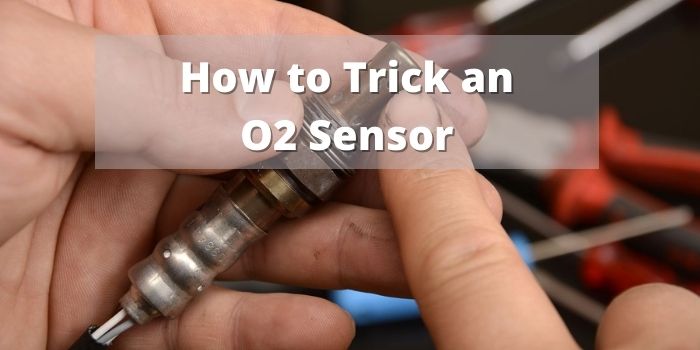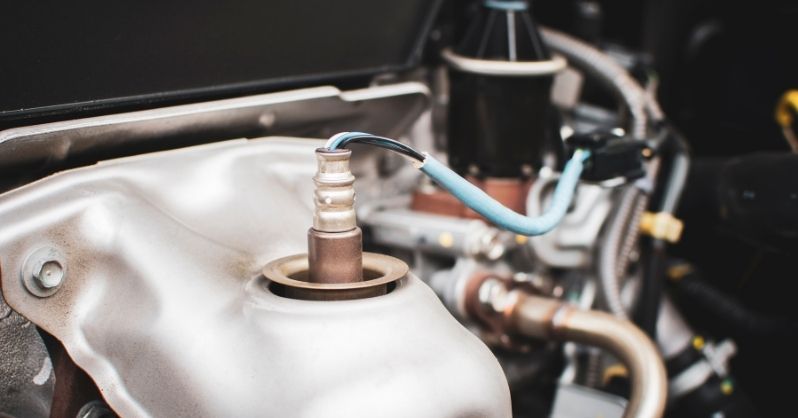The O2 sensor, along with many other sensors in your car, ensures that it runs without any issues and increases efficiency by miles. However, sometimes oxygen sensors may become faulty and may start to hamper the car’s performance. To avoid this, you might want to bypass the O2 sensor.
So, you can have your car running smoothly, we have written out a comprehensive guide on how to trick an O2 sensor. If you don’t know much about this sensor, you’ll also be glad to know that we’ll also be delving into all the details about it.

What Are O2 Sensors?
If you don’t know properly what O2 sensors are, you will have issues understanding the tutorial on how to trick them. Most modern cars have 2 oxygen sensors now, or at least you’ll find one O2 sensor in your car. This sensor is a very important part of the exhaust system, and it ensures that the engine functions efficiently. Additionally, if your car has a catalytic converter, then it will ensure that it works smoothly.
For combustion in the engine, your vehicle will need the ideal fuel to oxygen ratio, and the O2 sensor plays a key role in making sure this ratio is achieved. This sensor detects whether the mixture of air and fuel is too rich or lean. It does this by oxidizing some of the oxygen that is sent from the exhaust system. Based on the reading, the sensor then sends a signal to the computer that controls the engine. After that, the timing and fuel metering are adjusted to fix the fuel/air mixture.
Excessively rich means that there’s too much fuel than air in the mixture, and this can result in overheating, and the emissions when the engine runs rich cause more pollution. On the contrary, when a vehicle is said to be running lean, it means that there is too much air in the mixture, and this can lead to the vehicle jerking or hesitating during acceleration. Both of these issues can gradually damage your engine and decrease mileage.
When vehicles have 2 O2 sensors, one is called the upstream sensor, and the other is called the downstream sensor. The sensor that is near the engine and on the exhaust pipe is called the upstream sensor, whereas the one next to the muffler is called the downstream sensor.
Why Bypass the O2 Sensor?
There are a few reasons why one might want to bypass the O2 sensor, but the primary one is that you want your vehicle to run smoothly without a catalytic converter. Also, an O2 sensor is often bypassed because people want to turn off the engine light that would otherwise be always on.
The catalytic converter that you’re supposed to have may not be there because of some accident, or you may have removed it yourself for some extra horsepower. However, the issue is that when it’s not there, your working oxygen sensor will keep your check engine light constantly turned on.
A lot of people may find this light to be pestering while driving, or there may be other issues you may run into because of this. If you’re someone who goes out for off-road riding frequently, then you might see some improvement in performance upon tricking or deleting the O2 sensor.
Signs of a Faulty O2 sensor

A faulty O2 sensor could lead to a number of issues in your engine, and worse of all is that it could even damage your engine permanently. Hence, you want to look out for the symptoms of a faulty O2 sensor so you know when to delete it or replace it. There are many symptoms of this issue, but we will be discussing the most common ones below!
Illuminated Check Engine Light
A flashing or illuminated check engine light is one of the most common signs of a malfunctioning oxygen sensor. What’s worse is that the defective O2 sensor doesn’t turn the CEL by itself. It causes other components to malfunction, which then turns the engine light on.
Poor Fuel Mileage
It’s normal for fuel consumption to increase gradually. However, if it rises significantly after you have installed new O2 sensors, then there’s certainly an issue with the sensors. This occurs when the engine starts running either too rich or lean because the oxygen sensor isn’t working properly. You may also encounter this issue if your oxygen sensor has gotten old.
Failed Emission Tests
As we have said before, the oxygen sensor prevents the engine from running too rich, which would release a lot of pollutants in the air with the emissions. If your O2 sensor has become faulty, then it probably won’t be able to regulate the number of air contaminants released with the emissions. As a result, your car may keep on failing the emission tests, which is necessary to pass for the registration of the vehicle.
Degrading Performance, sudden stalling, or misfiring
When the fuel to oxygen ratio becomes off, your vehicle may misfire or stall suddenly. If your O2 sensor is the issue, then you’re also very likely to see your car rough idling as well. Failing oxygen sensors also result in the overall performance of your engine becoming worse and may cause a rapid decrease in power.
You are most likely to notice the rough idling first, and then your car will start to misfire. Then gradually, your engine will hesitate during acceleration and will provide more sluggish performance.
Rough Noises from the Engine
A common result of a malfunctioning O2 sensor is that the combustion chamber gets filled with a large number of carbon deposits. These deposits make some knocking noises as the engine runs, which can make it sound rough. You may not notice this symptom immediately, but if you do, you should check your O2 sensor at once.
How to Trick an O2 Sensor
There are a few easy ways of tricking an O2 sensor, and we will be discussing all 3 of them so you can pick the one you find the easiest.
Use a Dummy Oxygen Sensor
Using a dummy oxygen sensor is a very simple way to trick your O2 sensor. You just have to find where your actual O2 sensor is and then switch it out for the dummy oxygen sensor. This dummy is detected as an actual sensor by the engine computer. It will send signals to the engine control computer that everything is working fine, so your car runs smoothly without a catalytic converter.
However, you should keep in mind that this dummy won’t be able to fix the air-fuel ratio of the mixture. So, you won’t be getting the benefits of an actual O2 sensor.
O2 Simulators
O2 simulators are very similar to dummy O2 sensors, and some people may go as far to say that they’re the same thing. By working with capacitors and resistors, this simulator sends the correct wavelengths to the computer of the engine to trick it for an O2 sensor.
Sometimes O2 simulators may not work very effectively, so you have to keep it in check. You will have to spend a decent sum of money on this device because the cheap ones are very ineffective at bypassing the O2 sensor.
Connecting a Resistor to the Sensor
For those of you who can’t spend much money on a dummy O2 sensor, or an O2 simulator, you can use just a resistor to do the job for you. With your existing oxygen sensor, directly connect a resistor, and then it should be able to bypass the O2 sensor.
Much like the O2 simulator and dummy, the resistor will also trick the computer with signals that tell the O2 sensor is working perfectly. Attaching the resistor isn’t difficult. You have to unplug the sensor first and then use connectors to connect the resistor with it. After that, you just plug in the whole thing again.
For tricking the O2 sensor, a 50 ohms resistor should do the job; you don’t need one with very large resistance.
O2 Sensor Delete: A Complete Guide To Disable It
If you want completely disable or delete your O2 sensor, then we also have your back. This process isn’t too difficult, and anyone can do it if they have the right set of instructions, which is why we’re here.
Step 1: Prepare Your Vehicle
Before you start removing the sensor, there are a few things you have to do to ensure your safety. If you were just driving your car, you need to let it cool down first, or else working with it would be very uncomfortable. Then, you’ll have to loosen the nut of the negative battery cable that is at the terminal to disconnect it.
Step 2: Set up Your Vehicle
So that you can easily do the deletion, you need to lift up your vehicle, which will give you more space to work with. You can easily jack up the car using jack stands and by the front jack point.
Step 3: Locate the O2 Sensor
The O2 sensor looks a lot like a white spark and has a green wire with it. As we have mentioned in the article, the upstream sensor is on the exhaust pipe, and the downstream sensor is right next to the downstream sensor. A lot of cars may have four of these sensors, and some may even have just one.
Step 4: Disconnect the O2 Sensor
Once you have found the O2 sensors, you will need to follow the green wire that is right on top of each of them. By following the green wire, you will be able to find the wiring. Gently press on the tab of the sensor, then pull it out of the housing it is in. Then, with the help of an oxygen sensor removal tool, you will have to turn it counterclockwise, and then it should be completely unplugged.
After you have unplugged the sensor, take the disconnected green wire, and twist it into a loop. Do the same for all of the O2 sensors that you want to remove.
FAQs
1. Can I drive without a downstream O2 sensor?
Ans: Yes, your engine will run almost normally. Since the downstream sensor deals with the emissions, your car will fail the emission test and will make rough noises. However, you’ll still be able to drive.
2. Can O2 sensor cause a misfire?
Ans: When the O2 sensor isn’t working properly, it will send the wrong signals to the computer of the engine, which can result in misfiring.
3. Will a bad O2 sensor cause sputtering?
Ans: Yes, it can. The fuel amount in your engine may be disturbed by a defective O2 sensor, and this can make your car sputter.
4. Does a bad O2 sensor make noise?
Ans: Yes, it will most likely make your engine noisy. There will be an excess of carbon deposits in the combustion chamber when the O2 sensor has become bad. These solids will make knocking sounds when the car runs.
Final Words
Tricking an O2 sensor is often an important job for people who want their engine to feel powerful even without a catalytic converter. People who have a broken O2 sensor may also find it useful to bypass the oxygen sensor temporarily. As you’ve seen, it isn’t tough to trick an O2 sensor, but with our guide on how to trick an O2 sensor, it should be a child’s play for you!
If you notice any of the signs of a faulty O2 sensor in your car, get it checked immediately, and then you can just trick or delete the sensor to solve the problem.